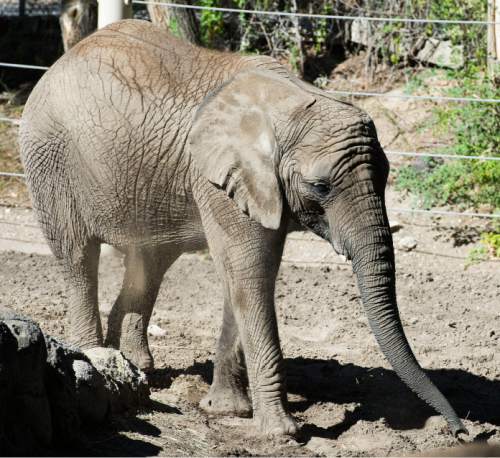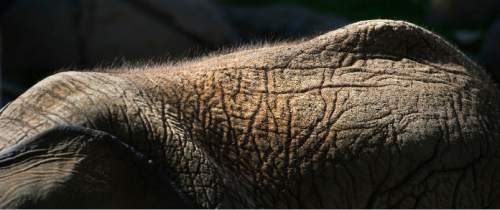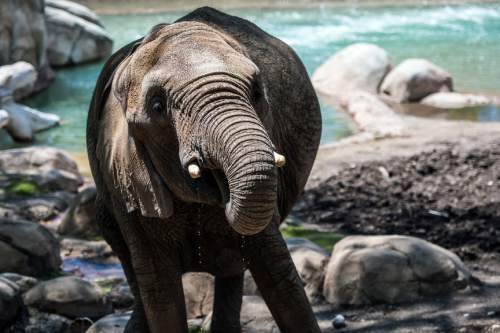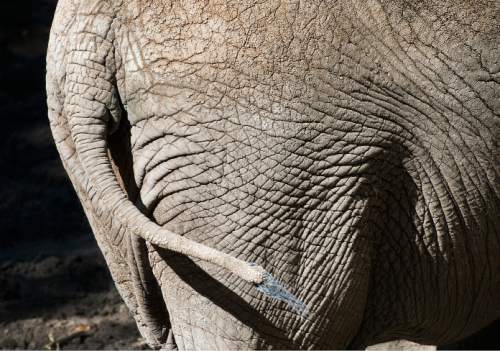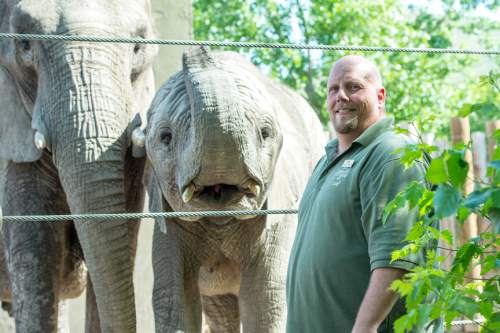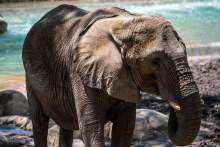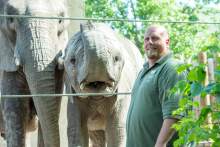This is an archived article that was published on sltrib.com in 2015, and information in the article may be outdated. It is provided only for personal research purposes and may not be reprinted.
Elephant manager Eric Peterson has been asked a lot of questions in his 21 years at Hogle Zoo, but this was a new one.
"Hi, my name is Josh Schiffman. How do I get some elephant blood?"
On a summer day in 2012, Schiffman had brought his three kids to see the African elephants, just as Peterson began a demonstration explaining how the zoo cares for the pachyderms inside and out — examining the bottoms of their feet and, once a week, taking blood from a vein behind their large ears.
That made Schiffman's own ears perk up. A pediatric oncologist at Primary Children's Hospital and an investigator at Huntsman Cancer Institute, he'd just returned from a conference about the evolution of cancer — and a discussion of how elephants, despite their large size and long lifespans, rarely get it. He wanted to study that phenomenon, thought to be related to elephants having 40 copies of p53, a tumor-suppressor gene, to understand how cancer spreads and, more importantly, how it can be stopped.
After the necessary paperwork and committee meetings, the zoo was on board.
Now, three years later, Schiffman has published his findings, which he hopes could lead to advances in how to treat — and prevent — cancer in humans.
Though a quarter of all people will die from cancer, just 5 percent of elephants do, Schiffman says.
"Evolution has had over 55 million years to learn how to prevent cancer in elephants. Now it's our turn to learn from nature how to prevent cancer in people," he says.
Most people have two copies of p53 — and those with Li-Fraumeni syndrome have just one, giving them a nearly 100 percent lifetime risk for cancer. Expecting that elephants' extra copies of p53 would rapidly repair their cells, Schiffman and other researchers introduced radiation and other DNA-damaging agents to blood samples from Hogle Zoo elephants, people with Li-Fraumeni syndrome, and people who served as a control group.
The elephants' cells began dying, and rapidly — an alarming turn of events, initially. But researchers soon realized that was "actually a brilliant strategy to avoid cancer," Schiffman says, more efficient than trying to stop cancerous cells from dividing and growing, and perhaps missing some in the process.
"It's almost as if the elephant had said, 'It's so important that we don't get cancer that we need an ultimate solution,' which would be just to kill the cell so it doesn't go on and develop cancer," Schiffman says.
Schiffman's research caught the attention of Ringling Bros. and Barnum & Bailey, whose head veterinarian heard him speak at a conference in 2013 and called him a few weeks later. The circus would soon be coming to Salt Lake City with its herd of Asian elephants; would Schiffman like some of their blood, and tickets to the show?
Yes and yes. The next week, Schiffman was downtown in the elephant tent at EnergySolutions Arena, texting frantically with Peterson at Hogle Zoo, coordinating a simultaneous blood draw between the elephants — down to the very minute, to ensure the samples could be compared.
This week, Ringling Bros.' Center for Elephant Conservation announced a new fundraising effort in conjunction with Primary Children's and Huntsman Cancer Institute to further Schiffman's research. The circus will make a donation of $20,000 in each of the next 50 cities it visits, with half that amount going to local hospitals and the other half going to Primary Children's Pediatric Cancer Research Program.
Schiffman plans to use that funding — and find much more — to "take this research from the elephants and apply it back to children and families who are most at risk for cancer, or who may already have cancer," he says. He hopes to find a known drug, synthetic or natural, that can replicate the effects of elephants' p53.
At the rate research is going now, he says, that'll take five or 10 years. "I'd like to hire 100 people and have them working on it day in and day out."
The success so far, he says, is due to how the project has become personal, with researchers working around the clock and connecting with people from different medical institutions — and the zoo.
Peterson says Schiffman kept him in the loop during the study, so he "knew how big of a deal it is" and was excited for his elephants to be part of it.
The process doesn't bother the elephants, Peterson says; they walk up to the edge of their area, lean onto the cables, and "present" an ear — flipping one out to expose the large veins, which help with cooling. And though they don't like the needle poke, they get rewarded the entire time blood is being drawn — "so they're always willing participants," Peterson says.
So was Peterson, who volunteered his blood as a human control. "Who doesn't want to help with cancer?" he asks.
He also hopes people will see that elephants — and animals in general — have value in the world. "Right now, 96 elephants are getting killed every day, just for their ivory," he says. "If they're extinct, they can't help with cancer. Who knows what other cures animals hold? This is the tip of the iceberg."
Schiffman says that he's not claiming that he's found a cure for cancer, or how to prevent it. But he hopes that his discovery can help shift the mood in the room when he tells parents that their child has a 100 percent of developing cancer because he or she is missing the p53 gene. Now he can add: "Right down the street at Utah's Hogle Zoo are elephants that have 40 copies of p53, and we are studying how to use them to help you."
Twitter: @racheltachel —
Pachyderm paradox
Large animals, with so many cells in their bodies, should have an exceedingly high rate of cancer due to sheer probability, yet humans' chances of developing the disease is much higher. The phenomenon, dubbed Peto's Paradox, led oncologist Josh Schiffman of the Huntsman Cancer Institute to study elephant DNA and discover that the animal's extra, slightly different copies of the p53 gene makes them cancer resistant.





